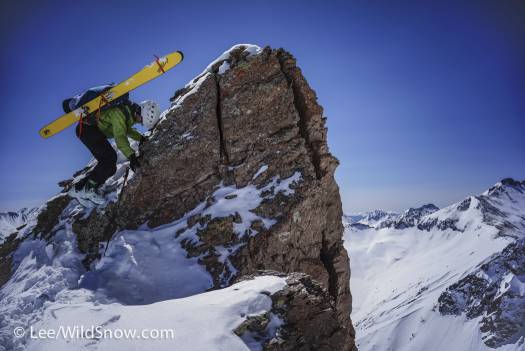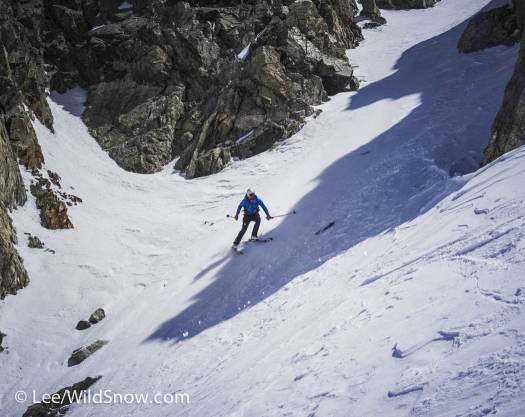April 17, 2015
I just shoveled out my car. The snow is thigh deep and still falling. So, now that Leadville, Colorado has returned to its winter state, I thought it would be a good time to reflect on spring turns and ski mountaineering here in the Rockies.
Skiing is the most fun thing I know how to do, and I spend as much time in the Colorado backcountry as I can, but I find myself especially giddy when spring comes around. Strangely I am almost sad about all the pow piling up outside. Don’t get me wrong, skiing the deep stuff is a blast, but what I think really makes Colorado’s high mountains a special place is what happens once that mushy spring stuff settles in.
Here in central Colorado we have mountains that are high, spectacular, but small enough that they are accessible. That access, however, is held at bay all winter long by avalanche hazard, road closures, brutal high mountain conditions, and a commonly shallow snowpack. Then the magic happens. Wet March snowstorms usually help fill in all those big lines that we drool over all winter long, then the April sun melts out any access problems and starts to offer the eager backcountry traveler enough safety to venture out into the high hills. (All this provided we don’t get any dust storms or ‘melting events’ — two things that have thankfully not yet occurred this season.)
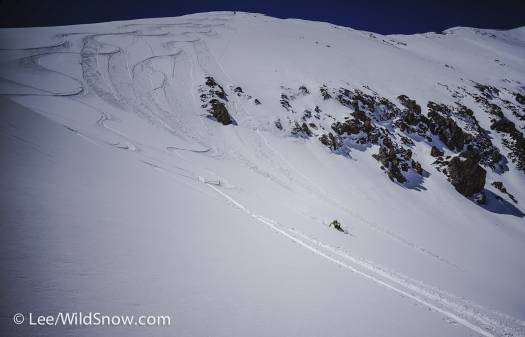
The best of both worlds near Independence Pass. Sometimes even great pow can be found in stable spring conditions.
It seems like every year I add more lines to the ‘to-do’ list than I tick off, but as a recent ‘Front Range refugee,’ arriving in Lake County, Colorado this past Fall, I have had to start from scratch this year, trading my Front Range plans for the High Rockies. I have been remarkably impressed with the springtime adventures to be had in the 10-mile-Mosquito and Sawatch ranges.
To the east and north of Leadville sits a world of seemingly tame, seemingly mellow, old mountains, eroded into rounded edges made all the less impressive by the teeth of the Holy Cross and Gore Ranges in the distance. These mountains, however, have their own secrets.
Two favorite adventures into the T-M-M of the past couple weeks have been the Northwest Face of Mount Fletcher and the Cristo Couloir on Quandary Peak.
Quandary is one of the most accessible 14ers in the state. Its East Ridge is a safe and easy introduction to winter conditions in the high mountains and sees a drove of travelers venturing up its ramparts whenever the sun shines. The Cristo provides the ski mountaineering counterpart to Quandary’s summit.
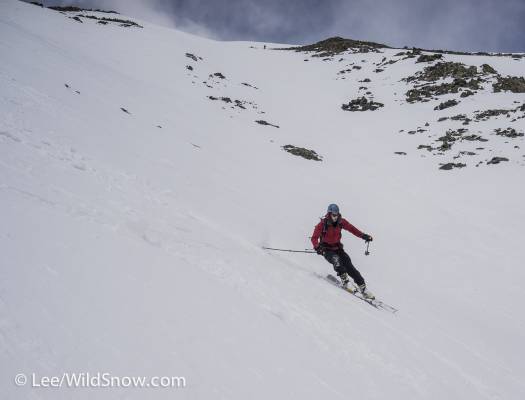
Safer and tamer than the North Couloir, Cristo Couloir offers more than 2500ft of spring turns from the summit down to Blue Lakes reservoir.
We got a ‘Colorado alpine start’ (I have been trying to make this term catch on) and began walking on dry dirt at around 9:30 am. It had been cold the past few nights and things were taking a while to warm up, so we felt this was early if anything. A few hundred yards past the gate we hit snow at Blue Lakes and with our skins left at the car we started climbing right from the dam.
(Safety note: timing for Colorado spring ski mountaineering is based on nighttime low temperatures and how cloudy or clear the sky is — along with what stage of settling and compacting the snowpack is in. While I was able to do some fairly late starts for the routes described here, doing so is not always wise and classic alpine starts are often necessary for safety. Many avoidable Colorado springtime avalanche accidents have been caused by starting too late in the morning.)
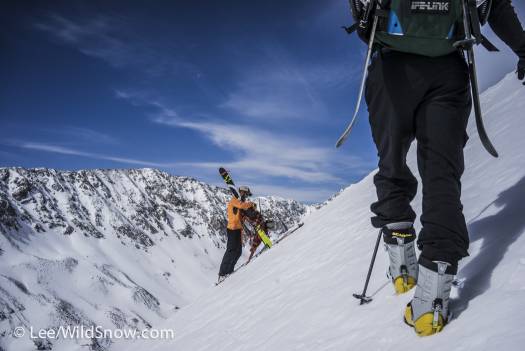
It was steep enough that I was happy to have an ice axe, but didn’t regret leaving crampons at home — two and half hours and a few summit shenanigans later we put on skis.
Fletcher is a high 13er in Mayflower Gulch. Rising above one of my favorite mid-winter ski destinations, I had been staring at this line all season and figured the time had come to go check it out.
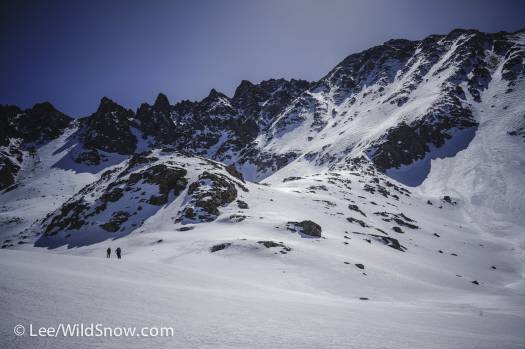
Mount Fletcher offers the other end of the ski mountaineering spectrum. The lines on the Northwest face have a fair amount of gnar to them, especially in the bulletproof conditions we found earlier this month.
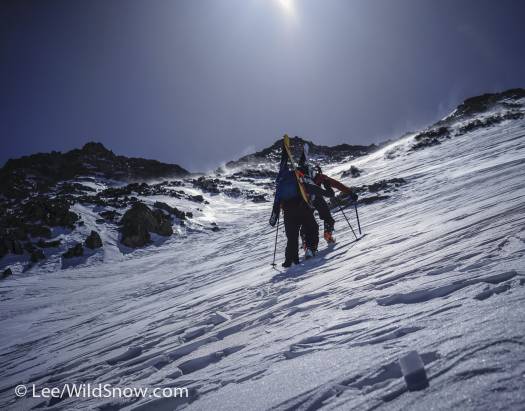
A proper boot-pack led us to the end of the deep-enough-to-ski snow a couple hundred vertical feet from the Mount Fletcher summit.
45 degree jump-turns on hard pack helped remind us why ‘mountaineering’ is an accurate part of the ski-mountaineering conjunction.
South and West of Leadville site the giants of Sawatch. In the heart of the Sawatch high peaks, Independence Pass and Twin Lakes offer the best access to big long lines I know of. When the road is open to the top of the Pass, 13,000 ft is just a short walk or ski away, and skiing can be found most of the year. My first turns of the season, back in October, were up there exploring the chutes of the Fourth of July Bowl. In Spring, below the road closure, the real prize of Colorado ski mountaineering can just as easily be found. Three thousand foot lines rise straight from the road up the mountains.
My favorite adventure of the spring in this area has been the Twin Peaks Couloir. Facing east and sitting on the edge of the range, I can see the line from my house in Leadville.
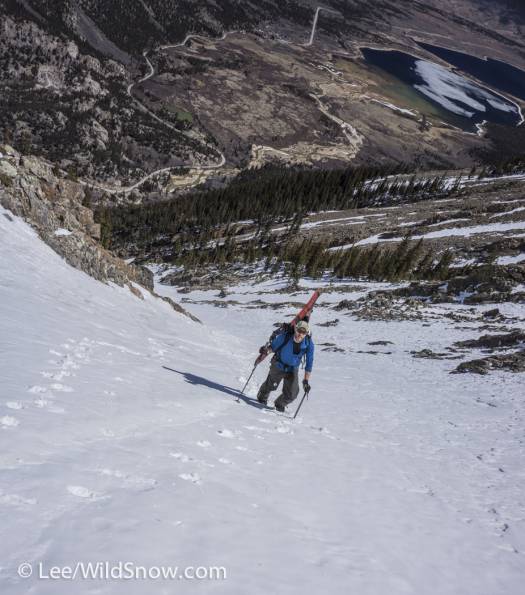
From town this thing looks wicked scary, but as is often the case, once on it, the fear of verticality dissipates with the reality of fun steep climbing and skiing.
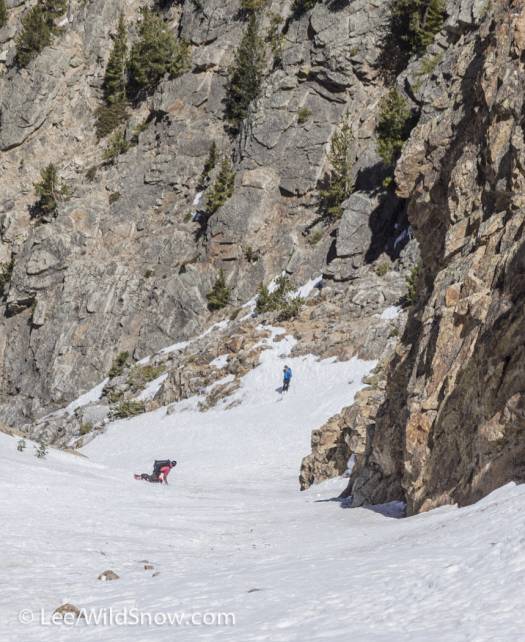
The bottom of the Twin Peaks line rolls through inset canyons presenting an opportunity to practice avoiding rocks and chase nearly every type of snow you can imagine.
I might not live in Jackson, the Wasatch, BC, or the Chugach, but the grace, beauty, and rugged lines in the High Colorado Rockies make it a place full of adventure — especially convenient adventure, considering each of the lines discussed above avoided the use of any alarm clocks and ended with beer and nachos back in town by 2pm.
If you can find any of Lou’s old guidebooks they’ve got lots of beta (see menu above) — his Fourteener guides have ski routes for every 14,000 foot peak in the state! He’s fooling around with a few guidebook websites; they’re worth a look. See backcountryskiingco.com And don’t forget Giterdone publishing. They’ve kinda taken over what Lou was trying to do with ink-paper guidebooks, review here.
(WildSnow.com Guest Blogger, Alex Lee, lives in Leadville, Colorado in the winter and Denali, Alaska in the summer. He is currently working towards a Ph.D. in the ethics of conservation at the University of Colorado. He works part-time as a naturalist in Alaska and as a ski guide and photographer in the Colorado Rockies. Like his pictures? Check out more at his website, MountainDinosaur.com.)
Dr. Alex Lee lives in Anchorage, Alaska. Alex is a professor at Alaska Pacific University, teaching philosophy and environmental studies. He also works as a sometimes guide, naturalist, writer, and photographer.

